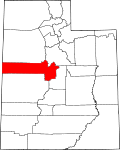History
The Mammoth Mine was discovered around the same time as the settlement of Eureka in February 1870. [4] Miners rushed in and began a boomtown. The area was remote and the environment harsh; no water was to be found nearby. The mines piped in water for industrial use, but residents had to buy drinking water for ten cents a gallon. [5]
Mines in the area around Mammoth produced ore, silver, and gold. The Mammoth Mine was in production for around seventy-five years. Considered part of the Tintic Mining District, with other communities and mines in the area, the area around Mammoth played a vital role in the mining economy of the Utah Territory and later the State of Utah.
Activity in Mammoth peaked around 1900–1910, with a population of 2500–3000. The town had a school, four large hotels, and other businesses typical of a town its size. Mammoth was officially incorporated in 1910, [5] but began to decline soon after. By 1930 the population was down to 750, [4] the town having disincorporated on 29 November 1929.
Today, some residents still consider Mammoth home. There is some smaller scale mining that goes on in the area today for metals.
The area is also popular with ghost town enthusiasts, campers, off-road vehicle riders, and hikers.
This page is based on this
Wikipedia article Text is available under the
CC BY-SA 4.0 license; additional terms may apply.
Images, videos and audio are available under their respective licenses.





